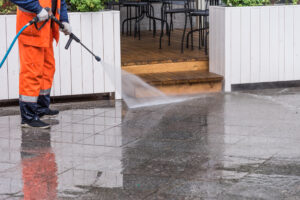East Valley 480-515-9652
Northern Arizona 928-226-0423

How to Pressure Wash a House
One of the most useful time-saving tools to emerge in recent years is a pressure washer. Cleans dirt, grime, and chalking paint from otherwise sound painted surfaces with its high-velocity water spray. Pressure washers are popular among professionals not just because they are quick but also because they scrub the old paint, allowing the fresh coat to adhere better.
How to Pressure Wash a House
A pressure washer is especially good at removing dirt, grime, and chalking, the powdered pigment left on the surface when old oil and latex paints degrade. You won’t need a cleanser (non-phosphate substitute or TSP) since the scouring action is vigorous.
Before pressure washing, check first for chalking by rubbing your hand on the painted surface. After that, you must repair such as replacing rotten boards and renailing loose ones so that water doesn’t drive through the wall and siding.
Pressure Washing Techniques
Practice first.
First, practice using the washer in a low area. Hold the wand in both hands and move it from side to side across the siding at a steady pace. Start approximately 2 feet away from the siding and work your way closer until you find the best cleaning distance. In general, work at a slightly downward angle to prevent pushing water up under the siding.
Work your way down from the top.
Initiate from the top and work your way down the walls. Wash the gutters, soffits, and siding as well. When possible, keep the spray away from breakable things like windows and exterior lights, and remove house numbers and window boxes.
After washing, scrape.
Pressure washers can help remove loose paint, but they can’t replace scraping. After pressure washing the area, scrape off any remaining loose paint.
Direct the nozzle away from windows.
Avoid driving water into joints, gaps, or against the glass by directing the nozzle away from windows and holding the wand at an angle. Even so, inspect the inside sill for any water that has spilled. After washing, remove the shutters and clean underneath.
Use an extension wand.
To wash high areas, use an adjustable extension wand. It is safer than pressure washing on a ladder.
Scrub the inaccessible areas.
With a scrub brush and a combination of TSP and detergent mixed in water, clean the high areas beyond the pressure washer extension. So that the TSP won’t leave noticeable drip marks on the siding, keep it damp. When finished, use a garden hose to rinse from the top down.
Other Tips on How to Pressure Wash a House
- While it is preferable to wash with the wand pointing downward, you may need to tip it upward at times, especially beneath soffits.
- We don’t suggest pressure-washing while standing on a ladder since the pressure’s rebound might knock you off balance.
- Steer clear of electrical equipment such as lights and outlets. It is easy to cause a short circuit or break them.
 When to Hire a Pro
When to Hire a Pro
If you like instant gratification for cleaning and house maintenance, pressure washing might be fulfilling for you. On the other hand, you could decide that pressure washing is too much hassle. And that’s OK! It’s a nasty task, and you’ll almost certainly end up soaked.
Contact a professional specialist for assistance if you’d rather have someone else do the pressure washing. With a bit of elbow grease and water, your house will be clean outside, just like inside.
